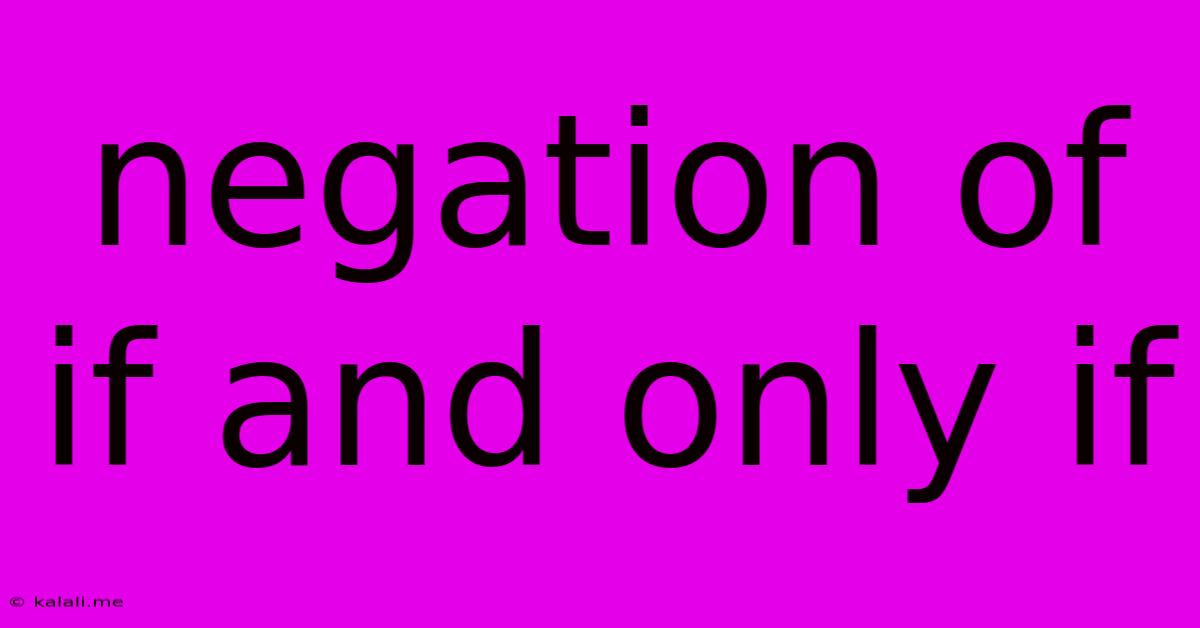Negation Of If And Only If
Kalali
May 28, 2025 · 3 min read

Table of Contents
Negating "If and Only If": A Comprehensive Guide
The phrase "if and only if" (often abbreviated as "iff") is a crucial component of mathematical logic and conditional statements. Understanding its negation is vital for constructing accurate and logical arguments. This article will provide a clear explanation of how to negate an "iff" statement, including examples and helpful strategies to avoid common pitfalls. This guide will help you master the intricacies of logical negation and strengthen your understanding of conditional reasoning.
What does "If and Only If" Mean?
Before tackling negation, let's solidify our understanding of "iff." A statement "P if and only if Q" (P iff Q) means two things simultaneously:
- If P, then Q: (P → Q) If P is true, then Q must also be true.
- If Q, then P: (Q → P) If Q is true, then P must also be true.
In essence, P and Q are logically equivalent; they are either both true or both false. They are essentially two conditional statements working in tandem.
Negating "If and Only If"
The negation of "P if and only if Q" is not simply "P if and only if not Q". Instead, it's a more nuanced statement:
¬(P ↔ Q) ≡ (P ∧ ¬Q) ∨ (¬P ∧ Q)
Let's break this down: The negation of "P iff Q" is true when either P is true and Q is false or P is false and Q is true. This captures the essence of the original statement being false; the two parts aren't logically equivalent.
Understanding the Negation:
The negation of "iff" asserts that P and Q have different truth values. They cannot both be true, and they cannot both be false. One must be true while the other is false.
Examples to Illustrate the Negation:
Let's consider some examples to illustrate the concept.
-
Original Statement: "A triangle is equilateral if and only if it has three equal sides."
-
Negation: "A triangle is either equilateral and does not have three equal sides, or it is not equilateral and does have three equal sides." This negation highlights the inconsistency; a triangle can't simultaneously be equilateral and lack equal sides, or vice versa.
-
Original Statement: "A number is divisible by 4 if and only if it is divisible by 2." (This is actually false – a key point is that the negation of a false statement is true).
-
Negation: "A number is either divisible by 4 but not divisible by 2, or it is divisible by 2 but not divisible by 4." This accurately reflects the cases where the original statement fails.
Practical Application and Strategies:
To effectively negate "iff" statements:
- Identify P and Q: Clearly define the two parts of the "iff" statement.
- Use the equivalence: Remember the negation is equivalent to "(P ∧ ¬Q) ∨ (¬P ∧ Q)".
- Translate into plain language: Ensure your negated statement is easily understandable and reflects the logical inconsistency.
- Consider truth tables: A truth table can visually confirm the equivalence between the original "iff" statement and its negation.
By understanding the nuances of negating "if and only if" statements, you can improve your logical reasoning skills and construct more robust and accurate arguments, whether in mathematics, computer science, or everyday reasoning. Remember to break down complex statements into simpler components, and use clear language to express your ideas precisely.
Latest Posts
Latest Posts
-
Brown Spider With Stripes On Back
May 30, 2025
-
How To Wire A Furnace Blower Motor
May 30, 2025
-
Low Side On Ac Is At High Pressure
May 30, 2025
-
Gather Ye Rosebuds While Ye May
May 30, 2025
-
Can You Bring A Laptop On Plane
May 30, 2025
Related Post
Thank you for visiting our website which covers about Negation Of If And Only If . We hope the information provided has been useful to you. Feel free to contact us if you have any questions or need further assistance. See you next time and don't miss to bookmark.